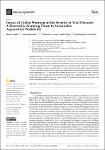Impact of Global Warming on the Severity of Viral Diseases: A Potentially Alarming Threat to Sustainable Aquaculture Worldwide
| dc.contributor.author | Combe, M | |
| dc.contributor.author | Reverter, Miriam | |
| dc.contributor.author | Caruso, D | |
| dc.contributor.author | Pepey, E | |
| dc.contributor.author | Gozlan, RE | |
| dc.date.accessioned | 2023-04-25T08:18:37Z | |
| dc.date.available | 2023-04-25T08:18:37Z | |
| dc.date.issued | 2023-04-17 | |
| dc.identifier.issn | 2076-2607 | |
| dc.identifier.issn | 2076-2607 | |
| dc.identifier.other | 1049 | |
| dc.identifier.uri | https://pearl.plymouth.ac.uk/handle/10026.1/20760 | |
| dc.description.abstract |
With an ever-increasing human population, food security remains a central issue for the coming years. The magnitude of the environmental impacts of food production has motivated the assessment of the environmental and health benefits of shifting diets, from meat to fish and seafood. One of the main concerns for the sustainable development of aquaculture is the emergence and spread of infectious animal diseases in a warming climate. We conducted a meta-analysis to investigate the influence of global warming on mortality due to viral infections in farmed aquatic animals. We found a positive trend between increasing temperature and increasing viral virulence, with an increase in water temperature of 1 °C resulting in an increase in mortality of 1.47–8.33% in OsHV-1 infected oysters, 2.55–6.98% in carps infected with CyHV-3 and 2.18–5.37% in fishes infected with NVVs. We suggest that global warming is going to pose a risk of viral disease outbreaks in aquaculture and could compromise global food security. | |
| dc.format.extent | 1049-1049 | |
| dc.format.medium | Electronic | |
| dc.language | en | |
| dc.publisher | MDPI AG | |
| dc.subject | viral diseases | |
| dc.subject | global warming | |
| dc.subject | one health | |
| dc.subject | sustainable aquaculture | |
| dc.subject | food security | |
| dc.title | Impact of Global Warming on the Severity of Viral Diseases: A Potentially Alarming Threat to Sustainable Aquaculture Worldwide | |
| dc.type | journal-article | |
| dc.type | Journal Article | |
| plymouth.author-url | https://www.webofscience.com/api/gateway?GWVersion=2&SrcApp=PARTNER_APP&SrcAuth=LinksAMR&KeyUT=WOS:000979410500001&DestLinkType=FullRecord&DestApp=ALL_WOS&UsrCustomerID=11bb513d99f797142bcfeffcc58ea008 | |
| plymouth.issue | 4 | |
| plymouth.volume | 11 | |
| plymouth.publication-status | Published online | |
| plymouth.journal | Microorganisms | |
| dc.identifier.doi | 10.3390/microorganisms11041049 | |
| plymouth.organisational-group | |Plymouth | |
| plymouth.organisational-group | |Plymouth|Faculty of Science and Engineering | |
| plymouth.organisational-group | |Plymouth|Faculty of Science and Engineering|School of Biological and Marine Sciences | |
| plymouth.organisational-group | |Plymouth|REF 2021 Researchers by UoA | |
| plymouth.organisational-group | |Plymouth|Users by role | |
| plymouth.organisational-group | |Plymouth|Users by role|Academics | |
| plymouth.organisational-group | |Plymouth|REF 2021 Researchers by UoA|UoA07 Earth Systems and Environmental Sciences | |
| dc.publisher.place | Switzerland | |
| dcterms.dateAccepted | 2023-04-13 | |
| dc.date.updated | 2023-04-25T08:18:31Z | |
| dc.rights.embargodate | 2023-4-26 | |
| dc.identifier.eissn | 2076-2607 | |
| dc.rights.embargoperiod | forever | |
| rioxxterms.versionofrecord | 10.3390/microorganisms11041049 |


